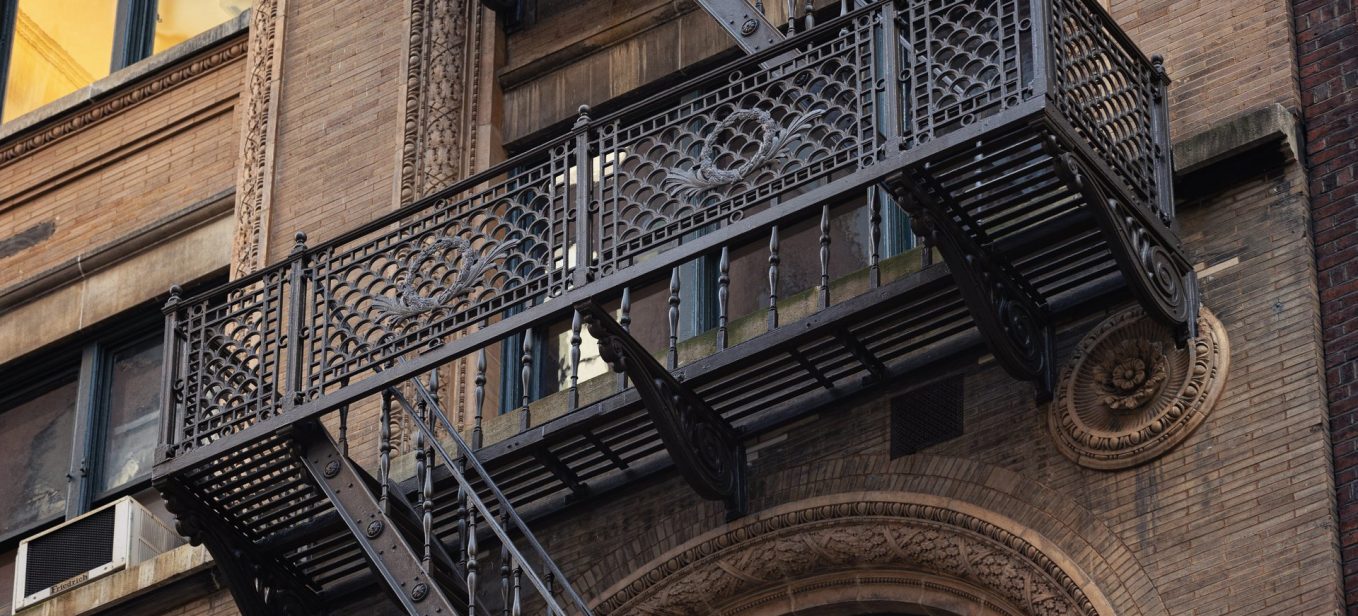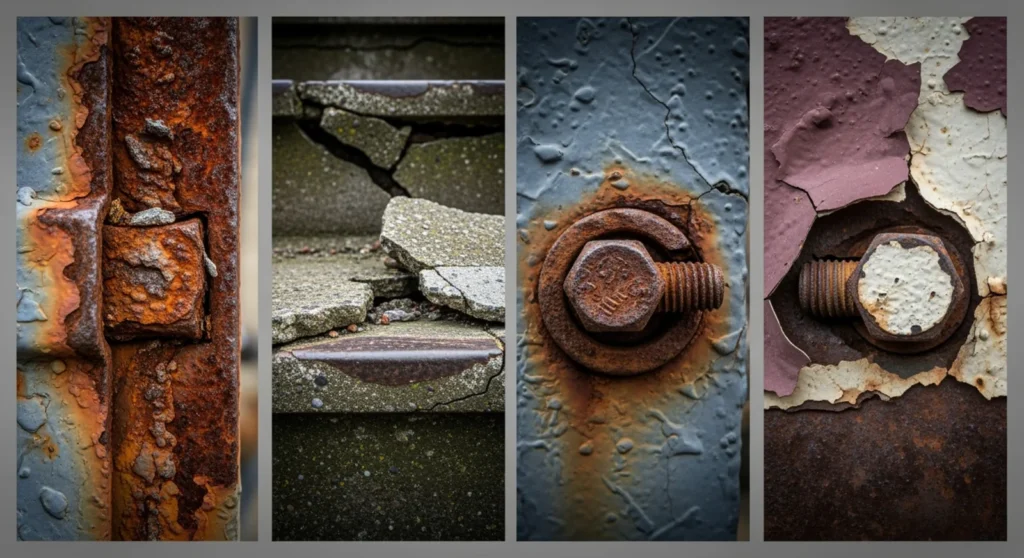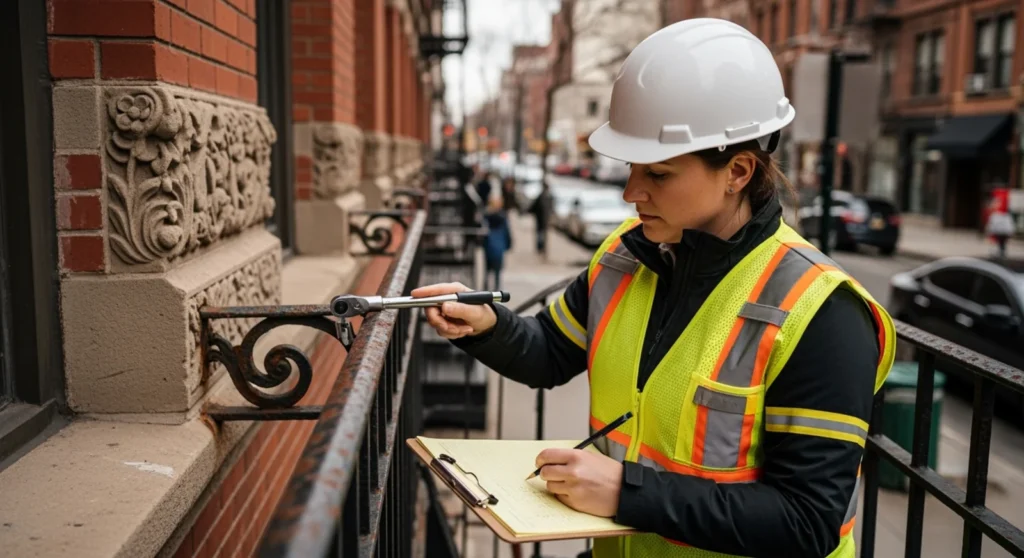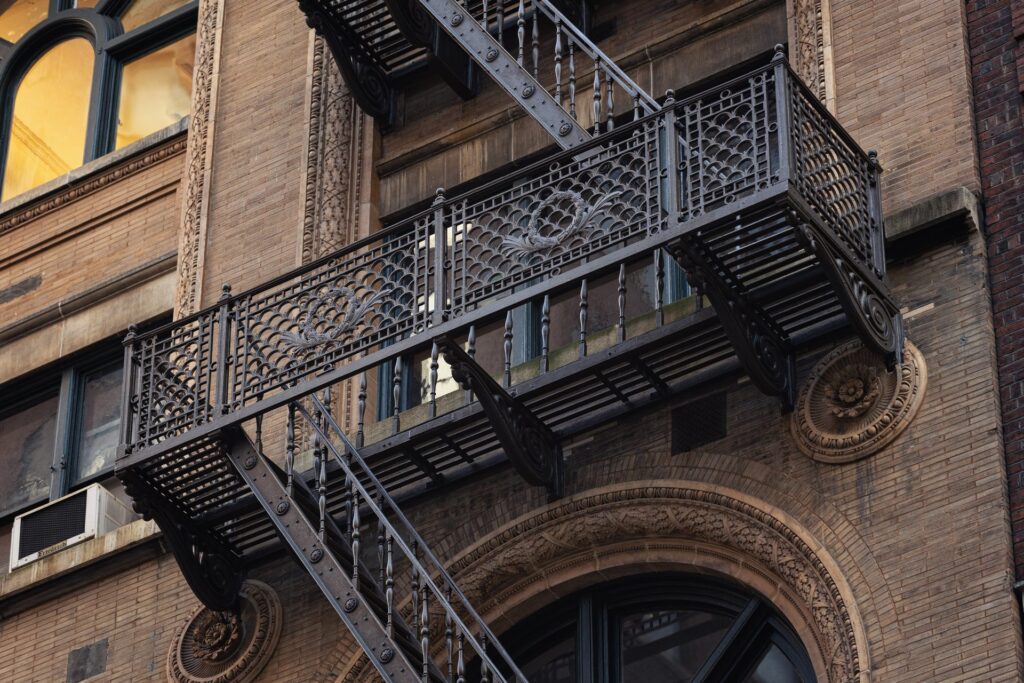
An Overview of the Fire Escape Repair Process
- By: Nova Construction Team
- Published:
- Updated: December 19, 2025
For anyone who owns or manages a building, keeping fire escapes in good working order goes beyond simply knowing what they are — it’s about understanding what it takes to maintain their safety and functionality while ensuring compliance with safety standards.
Fire escape restoration is a comprehensive process that makes sure these critical means of egress stay in good shape and meet all safety codes.
Professional fire escape restoration includes a thorough inspection, rust removal, tightening loose bolts, structural repairs, and protective coating application.
This article will walk you through every step of the process, explain why it’s important to prioritize these safety measures, and help you handle each part to ensure your fire escape maintains its structural integrity.
What Happens During Fire Escape Repair?
Fire escape restoration is a comprehensive set of tasks aimed at restoring and maintaining your building’s emergency exit functionality while ensuring compliance with current building safety regulations.
Professional fire escape restoration services go beyond simple repairs — they involve looking at the whole system to preserve its structural integrity and keep it ready in case occupants need to use this reliable means of egress quickly.
This restoration process involves a comprehensive assessment, a detailed plan for any structural issues found, and then the restoration work itself to get the fire escape back into optimal condition, following all legal requirements.
The main steps of restoration services include checking for deterioration, making a plan to address structural problems, and performing the restoration work — ranging from minor touch-ups to major reinforcement projects.
The goal is to make the fire escape structurally sound and ensure safety so it can effectively serve as a durable means of egress in an emergency.
Why Do Fire Escapes Need Repairs?
Fire escapes serve as essential safety and functionality components, not just decorative facade elements. They provide a backup way for occupants to leave a building if the regular exits can’t be used.
Over time, weather exposure, constant use, and general wear can cause significant deterioration. This deterioration can make fire escapes a serious hazard if restoration needs aren’t addressed promptly.
Safety codes require regular inspections and restoration to ensure safety for all building occupants. By following these legal requirements, owners avoid fines and reduce risks.
Making restoration a priority keeps fire escapes maintaining their structural integrity and meets compliance standards. Whether it’s a historic landmark building or modern structure, restoration services help extend the life of your fire escape while preserving its essential functionality.
Common Reasons Fire Escapes Get Damaged

Fire escapes face constant exposure to harsh conditions, which can lead to various structural issues:
- Rust and Corrosion: Metal components, including railings and support structures, can rust when exposed to moisture and air, compromising structural integrity and requiring urgent restoration attention.
- Loose Bolts: Over time, bolts may loosen due to weather changes or everyday use, making the structure unstable and requiring immediate reinforcement through tightening loose bolts.
- Broken Steps: Cracks or breaks in steps create a serious hazard during emergencies and need immediate restoration work to ensure safety.
- Deteriorated Coating: Old or peeling protective coating lets in water that accelerates rust and structural deterioration, making recoating a crucial part of any restoration project.
- Compromised Masonry and Brick Elements: In older buildings, especially landmark structures, deteriorating brick and masonry connections can affect the fire escape’s attachment to the building facade.
- Blocked or Unstable Paths: Items stored on landings, overgrown plants, or uneven surfaces can prevent occupants from using this reliable means of egress quickly during emergencies.
Important Safety and Legal Points
Property owners must follow both general building codes and fire safety standards, which can differ by city or state. In NYC, projects must meet particularly stringent requirements. Not maintaining compliance can cause fines or lawsuits, and, more importantly, puts lives at risk by compromising building safety.
Legal requirements often specify how often to inspect the structure, what constitutes adequate structural integrity, and how to maintain proper functionality.
Many cities, for example, require load testing every five years to ensure a fire escape can handle sufficient weight during emergencies, following OSHA guidelines for occupant safety.
Building owners should stay current with these safety standards and need to hire experts who understand local compliance requirements.
Following these safety codes isn’t just about avoiding legal trouble — it’s about ensuring your fire escape serves as a dependable means of egress and maintaining overall building safety.
How Can You Tell a Fire Escape Needs Repairs?
Identifying issues early helps you address minor problems before they turn into major, expensive restoration projects.
Many warning signs can be spotted through regular visual inspections of the structure. Being alert to these issues can keep your fire escape maintaining proper safety and functionality.
| Sign | What It Means | Action Needed |
|---|---|---|
| Rust and Corrosion | Orange-brown patches, especially in joints or brackets | Remove rust and repaint to stop further damage |
| Loose or Missing Bolts | Wobbly handrails or steps | Tighten or weld bolts securely |
| Broken Steps | Cracked or missing stair treads | Replace or fix steps right away |
| Blocked/Unstable Pathways | Path is blocked or feels unsafe | Clear obstructions and check for stable surfaces |
| Chipped or Peeling Paint | Paint flakes off, exposing metal | Repaint to protect against moisture and rust |
Which Rules and Codes Apply to Fire Escape Repairs?

Understanding and maintaining compliance with the many regulations about fire escape restoration is essential for every building owner or manager. Different locations have specific safety codes, but national guidelines from organizations like the International Fire Code (IFC), National Fire Protection Association (NFPA), and OSHA provide foundational safety standards.
Cities like NYC may add extra legal requirements, such as more frequent inspections or higher structural standards for restoration services in NYC.
- Building Safety Codes: Both national and local safety codes specify inspection frequency, structural integrity requirements, and how to maintain clear means of egress for occupant safety.
- Load Testing Requirements: Owners must demonstrate their fire escapes can support required loads, often tested every five years. Passing these tests ensures the structure meets all safety standards.
- Restoration Methods: Welding may be limited or prohibited in some areas because it can compromise older metal structures. Professional fire escape restoration typically prioritizes bolted connections for better durability and easier future inspections.
- Lead Paint Regulations: For buildings constructed before 1978, special legal requirements apply for coating removal. Restoration work must be performed by skilled technicians trained and licensed to work safely with hazardous materials under EPA guidelines.
How Does the Fire Escape Repair Process Work?
Professional fire escape restoration follows a systematic series of steps that ensure high-quality results while maintaining compliance with all safety standards.
- Inspection and Comprehensive Assessment: Skilled technicians conduct thorough inspections to ensure all structural issues are identified. This comprehensive assessment documents every problem, including detailed photos and videos of deterioration patterns.
- Restoration Planning: Using the assessment results, restoration services develop a detailed plan. This plan outlines every task needed to restore structural integrity and ensure the fire escape meets all safety standards.
- Structural Restoration Work: Expert teams carry out the restoration project systematically. Services include professional rust removal, tightening loose bolts, reinforcement of weakened areas, railing repairs, and addressing any masonry or brick connection issues.
- Surface Preparation and Coating: After structural restoration, old coating and rust are completely removed, metal surfaces are properly prepared, rust-preventing primer is applied, and durable protective coating is installed. For historic landmark buildings, restoration work follows preservation guidelines. Sealing joints prevents water infiltration and extends the life of your fire escape.
- Final Inspection and Certification: Upon completion, skilled technicians perform final inspections, sometimes including load tests to verify structural integrity. If the restoration project meets all safety standards, certification is issued confirming the fire escape serves as a reliable means of egress and maintains full compliance with building safety codes.
Should Fire Escape Repairs Be Done by Professionals?
Because of the critical safety and functionality requirements and strict compliance standards involved, fire escape restoration should always be handled by professional fire escape restoration specialists.
Attempting DIY restoration can be unsafe and could violate legal requirements. Skilled technicians have the expertise and equipment needed to perform restoration work safely while ensuring compliance with all safety codes.
What Should You Look for in a Fire Escape Repair Contractor?
- Experience specifically with fire escape restoration in NYC and other jurisdictions
- Valid licenses and certifications, including EPA lead-safe certification for older buildings
- OSHA compliance training for occupant and worker safety
- Membership or training from organizations such as the National Fire Escape Association
- Proven track record with residential and commercial restoration projects
- Clear contracts and written estimates for restoration services
- High-quality materials and durable protective coatings
Why Hire a Professional?
- They understand local safety codes and legal requirements
- They use proper materials and techniques for lasting durability
- They can identify and solve hidden structural issues early
- They provide official documentation and certification after restoration work
- They ensure your fire escape meets all safety standards and serves as a reliable means of egress

What Happens After Repairs Are Done?
After your fire escape restoration project is finished, there are important steps to complete and ongoing maintenance to preserve its functionality and ensure safety.
- Obtain Certification: Professional fire escape restoration services will provide certification showing the structure meets all safety standards and maintains compliance with building safety codes. Keep this documentation for inspections, insurance, and legal requirements.
- Schedule Regular Inspections: Plan annual inspections, or more frequently if local safety codes require. Every five years, most jurisdictions require detailed structural assessments by qualified engineers or architects to identify any developing issues early and maintain the life of your fire escape.
How Does Regular Maintenance Help Prevent Future Repairs?
Prioritizing routine maintenance can significantly extend the life of your fire escape and avoid major, costly restoration projects later.
Here’s how to preserve structural integrity:
- Conduct regular visual inspections for rust, coating deterioration, or loose connections.
- Keep areas clear of storage, clutter, and vegetation that could create hazards.
- Quickly address coating damage to prevent moisture infiltration and deterioration.
- Ensure all doors leading to fire escapes function properly and remain unobstructed.
- Address even minor structural issues immediately — fixing small problems now prevents major restoration needs later.
For residential and commercial properties, especially historic landmark buildings, regular preservation efforts protect both safety and structural integrity while maintaining compliance with evolving safety standards.
Summary Table: Fire Escape Maintenance Checklist
| Task | Frequency | Action |
|---|---|---|
| Visual Inspection | Every 6-12 months | Look for visible damage or wear |
| Remove Obstructions | As needed | Keep landings and stairs clear |
| Paint Touch-Up | When chips appear | Sand, prime, and paint exposed areas |
| Professional Inspection | Yearly (unless local code requires more often) | Hire an expert to look for deeper problems |
| Load Test / Certification | Every 5 years (per local law) | Engineer or architect inspects and certifies |
By prioritizing regular maintenance, property owners prevent larger restoration projects and keep their fire escape ready to serve as a dependable means of egress at any time.
Consistent preservation efforts extend the life of your fire escape, ensure safety for all occupants, and maintain compliance with building safety requirements.
Contact Us Today for Professional Fire Escape Restoration Services
Don’t wait until minor issues become major hazards requiring urgent restoration work. Professional fire escape restoration services can conduct thorough inspections to ensure your building maintains proper safety and functionality.
Contact us today to schedule a comprehensive assessment of your fire escape’s condition. Schedule a consultation with our skilled technicians to discuss your restoration needs and ensure your fire escape continues to serve as a reliable means of egress while meeting all current safety standards.
Got a project in mind? Let's chat about bringing your construction vision to life!
